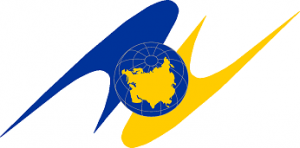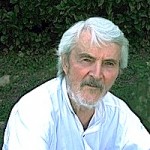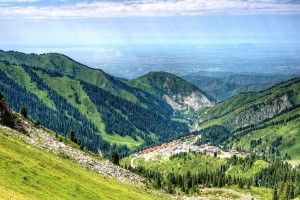
Chymbulak, Kazakhstan Photo by dr_sweet_al  … Attribution-NoDerivs License
… Attribution-NoDerivs License
=By= Gaither Stewart
(Extract from my Iranian diary; a Saturday in June, 1900s) Again, in the early morning, we had driven through the rugged Elburz Mountains from Tehran to the Caspian Sea, then west-northwest up the Caspian coast as far as Ramsar, and then doubled back east along the shore. I, the official interpreter, had wanted to head westwards for Tabriz and Azerbaijan, but the Italian businessmen were most eager to find a good fish restaurant. They entered the first place we saw. The Iranian-Armenian broker and I stood in silence at water’s edge. I was dreaming Caspian … and wondering about the distance to the northwest corner where the Volga River flows into this, the world’s largest enclosed body of water lined in the south by the Elburz and in the west by the great Caucasian mountains just out of our sight but whose presence we felt, range after range, peak after peak, crags and hidden streams. An impregnable fortress. The northern exposure here on the Iranian shores of the Caspian at the small town of Sulaleh is an enlightening geographical experience. We speak in the Armenian’s nearly native Russian as a result of his university studies in Yerevan, Armenia before his emigration to Iran. He points to the west to indicate his present home in Tabriz, Iran. Involuntarily, I mutter the names of cities on the western coast of the Caspian: oil-rich Baku in Azerbaijan (that today the U.S. so wants to get its hands on as it does on Armenia and occupy as it has their southern neighbor Georgia with all is wines and champagne.)I think of the North Caucasian Makhachkala, the capital of Russia’s Dagestan, occupied by the British during the Western intervention in the Russian civil war in 1919 before the city was occupied by the new Red Army in 1920. We speak of the genocide of the Armenians on Mt. Ararat perpetrated by the Turks. I tell him of my private Turkish language teachers, the first a Karachay from the confusing mix of peoples of the North Caucasus on the northen slopes of those great mountains; the second a real Kazakh from Kazakhstan. Both of their native languages are Turkic, transformed and consolidated in university studies in Turkey before their immigration to Germany. The engineer says I would like Tabriz where the street language is Azerbaijani Turkish, nearly Anatolian. My eyes shift to the eastern shores in search of the country of Turkmenistan before roaming northwards toward Kazakhstan. The huge Caspian Sea does look like a full-fledged sea. Yet only puny waves are rolling in, even though the southern part of the sea is said to reach over one thousand meters depth. Located between Europe and Asia the Caspian retains waters from the great Volga and Ural Rivers, the latter considered the dividing line between Europe and Asia. Hard to believe that it has no outflows. All its waters converge into surrounding lakes and swamps that nature equilibrates through evaporation. There was no chance to get to Kazakhstan over one thousand kilometers to the north and its flanks spread along the sea’s northeastern shores … but I felt it there. I do not tell the Iranian of my sensation of being very near the top of the world. I felt it was there, north of the Caspian, the top of the world, the center, where time perhaps stands still in which vacuum you perceive lies enormous power. The thing about this location on the Caspian is that you sense the presence of another world up there and that it has a core, the existence of which will one day surprise the world.
Up there to the north, Kazakhstan! A country of water, magnificent canyons and rolling steppes, located in northern Central Asia, a small part of which extends west of the Ural River into Eastern Europe. The land of the Kazakhs is the world’s ninth largest country, larger than all of Western Europe together. Hard to imagine from the banks of the Caspian, much more so from the deep West. In all its manifestations nature in these parts is immense—its seemingly bottomless seas, soaring mountains, endless grasslands, limitless borders and Kazakhstan’s sparse population of only eighteen million people combine to create a feeling of boundlessness, even though, at the same time, it has the distinction of being the world’s largest land-locked country. Both land-locked, the Caspian waters and the Kazakhs themselves.
Though land-locked, Kazakhstan today has aspirations for emergence into the contemporary world. Above all—as my Iranian-Armenian friend could never have imagined—it is a key link in the chain of countries constituting the Eurasian Economic Community founded in the year 2000 by an ambitious Russia conscious of the necessity to reassemble key parts of its lost empire—a dissolution which in my opinion should never have happened—in order to counter U.S. aggressiveness in these distant lands Washington will never understand. Today it seems a geographical blessing that Kazakhstan shares borders with both Russia and China. Its geographical place in Central Asia, its position in Eurasia and its great part of the huge Caspian Sea make the land very much part of the world at large.
The sprawling country became independent in 1991 following the dissolution of the USSR of which it was part. By 2006 it had become the dominant economy in Central Asia (which includes also Uzbekistan, Turkmenistan, Kyrgyzstan, Tadjikistan and on which world powers today have their eyes cast), an economy based primarily on its oil/gas industry, in addition to vast mineral resources. The current President of Kazakhstan, Nursultan Nazarbayev, has led the country since 1991 and is known as authoritarian with a less than clean record of human rights abuses and suppression of political opposition. Though difficult to control the rise of dictators in such areas, this is home territory for Russia and my hunch is that the nearer Kazakhstan draws to Russia, the weaker Nazarbayev’s position will become.
The name Kazakh derives from an ancient Turkic word meaning “to wander”, reflecting the people’s nomadic culture, the same as the name “Cossack”. The “stan” suffix is Persian, meaning land or place. Kazakhstan, “the land of nomads”. Though traditionally referring only to ethnic Kazakhs, today the term ”Kazakh” tends to refer to all inhabitants of Kazakhstan, including many ethnic Russians.
THE ARRIVAL OF THE RUSSIANS
After the Mongolian occupation of the territory in the 13th century, the Kazakhs emerged as a distinct people. As Russia recovered from that same occupation, it felt a natural attraction to the limitless East. In the 18th century Russian empire builders advanced into the Kazakh steppe and by the mid-19th century ruled the land as part of the former imperialistic Russian Empire. After the Russian Revolution, the land of the Kazakhs became the Kazakh Soviet Socialist Republic in 1936, an integral part of the Soviet Union.
Why direct our attention today to this sprawling nomadic land of 18 million people that is Kazakhstan? Geopolitics! Geopolitical strategy! Kazakhstan in a key member of Russia’s Eurasian Economic Community, EEC—an idea actually first proposed by Kazakhstan in year 2000—linked to the maturing Sino-Russian alliance and China’s new-era, forward-looking Silk Road planning. Active members of the EEC at this point are: Russia, Belarus, and Kazakhstan, the goal of which is the creation a free trade zone among member nations under a common customs union.
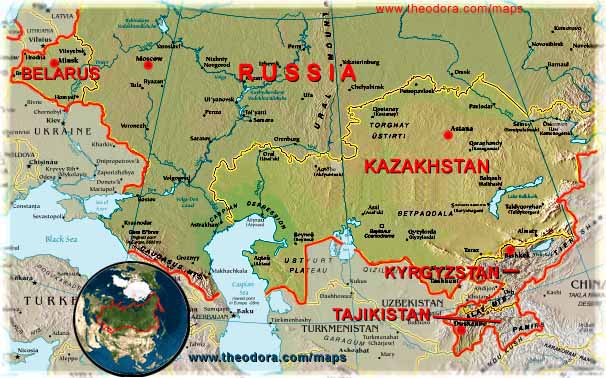
Map of EEC nations courtesy Photius
The Eurasian Economic Community (EEC) is an economic union of states primarily in the northern part of Eurasia. The first treaty which came into force on January 1, 2015 was signed by leaders of Russia, Belarus, and Kazakhstan. Then were added the Central Asian countries of Kyrgyzstan and Tadjikistan. Treaties concerning adhesion to the customs union soon came into force also in Armenia in the Caucasus—despite Armenian temptations to join the European Union—now apparently destined for membership in the Russian-led EEC. Uzbekistan with its 30 million population is still hesitant but can hardly not join its neighbors. The nations of the EEC begin at the eastern end of Europe, bounded by the Arctic in the north, the Pacific Ocean to the east, and to the south, East Asia and the Middle East. The area of the union extends across much of northern Eurasia, its member states covering an area of twenty million square kilometers, approximately 15% of the earth’s land surface.
Many of their politicians and political scientists have since called for further integration towards a political, cultural and military union (as is happening also in the European Union today). However, Kazakhstan has insisted the union remain primarily economic, preferring to retain its full sovereignty. Nonetheless, two member states, Belarus and Russia, already form a political union.
The Eurasian Economic Community already has an integrated single market of 183 million people and a GDP of over 4 trillion U.S. dollars The EEC means the free movement of goods, capital, services and people and provides for common transport, agricultural and energy policies, with provisions for a single currency and greater integration in the future. The union operates through supranational and intergovernmental institutions. The Supreme Eurasian Economic Council is the “Supreme Body” of the Union, consisting of the Heads of member states and other supranational institutions, the Eurasian Commission (the executive body), the Eurasian Intergovernmental Council (consisting of the Prime Ministers of member states) and the Court of the EEU, the judicial body.
The EEC has thus quickly become a powerful politico-economic alliance. Today again, at home in Rome, just as that day on the banks of the Caspian Sea, I lost myself and my sense of time, feeling myself practically inside this same vast expanse as depicted in my huge world atlas. Again, I feel the almost ungraspable immensity of Eurasia and everything in it. To think only of the old Silk Road from China through these parts on its winding way to tiny Venice on its tiny lagoon is mind-boggling. A trip length measured in those early times not in weeks or months but in entire seasons: departure in Spring and hopeful arrival in the Fall. Of exotic caravanserai in the great deserts of Central Asia, of deep seas, meandering lakes, and rivers to navigate, of rugged mountains to be negotiated. And today China’s precise project of high-speed railways to connect China and Europe. An expanse so vast that the high-speed rail voyage will still require weeks.
Linked to a traditional nomadic people and perhaps genetically to the memory of the original Silk Road from China to the West, Central Asia has always been a crossroads for the movement of peoples, goods and ideas between East and West. Geopolitical strategists too consider Central Asia the core region of the continent of Asia itself, stretching eastwards from the Caspian Sea and Kazakhstan in the west to China in the east and from Afghanistan in the south to Russia in the north. Though more a geographical concept Central Asia includes five former republics of the USSR: Kazakhstan (18 million people), Kyrgyzstan (6 million), Tadjikistan (8 million), Turkmenistan 5.2 million), and Uzbekistan 31 million, a total population of over 65 million, plus, again geographically, Afghanistan’s over 30 million. So we are speaking of nearly 100 million people occupying a sparsely populated key oil and mineral rich area at the top of the world. Therefore, the expectation that Washington will ever give up voluntarily its hold on Afghanistan seems like wishful thinking.
In pre-Islamic times, Central Asia was an Iranian region including Iranian-speaking peoples, both sedentary and nomadic like the Scythians and Parthians. But with the expansion of Turkic peoples Central Asia became the home of those Turkic-speaking peoples of the above former Soviet republics. But something of the former Iranian connection must have remained: the Tadjiks and some peoples of Uzbekistan speak a variety of Iranian. When years ago I spent time in Iran the Russian presence was strong and its embassy a landmark of the city of Tehran. Today’s close Russo-Iranian relations are no surprise; their relationship is not only geographical but also historical and genetic, a factor about which U.S. strategic planners do not seem to have a clue.
In 2014, Kazakhstan gave Ukraine humanitarian aid during the conflict of the U.S./NATO- backed Kiev government with Russian-backed Novorossiya. In October 2014, Kazakhstan donated $30,000 to the International Committee of the Red Cross’s humanitarian effort in Ukraine. Then in January 2015, Kazakhstan sent $400,000 of aid to the anti-Kiev southeastern regions of Novorossiya. Of the war in Ukraine, Kazakh President Nazarbayev said: “The fratricidal war has brought true devastation to eastern Ukraine, and it is a common task to stop the war there, strengthen Ukraine’s independence and secure the territorial integrity of Ukraine.” Apparently, no matter how the Ukraine crisis develops, Kazakhstan’s relations with the European Union are likely to remain normal. According to Kazakhstan’s Astana Times newspaper Nazarbayev’s mediation is positively received by both Russia and Ukraine. Kazakhstan’s Ministry of Foreign Affairs released a statement on 26 January 2015: “We are firmly convinced that there is no alternative to peace negotiations as a way to resolve the crisis in the southeastern Ukraine.” Such statements by Kazakh leadership reflect that country’s harmony with Russia’s present policy regarding Ukraine.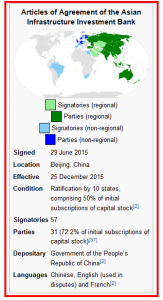
ROAD SILK ECONOMIC BELT
When Chinese leader Xi Jinping visited Central and Southeast Asia in September and October 2013, he raised the initiative of jointly building the Silk Road Economic Belt and simultaneously the 21st-Century Maritime Silk Road. Essentially, the ‘belt’ includes countries situated on the original Silk Road leading through Central Asia, West Asia, and the Middle East to Europe. The initiative calls for the integration of the entire region into a cohesive economic area through building infrastructure, increasing cultural exchanges, and broadening trade. Many of the countries that are part of this belt are also members of the China-led Asian Infrastructure Investment Bank (AIIB). North, central and south belts are proposed. The North belt is to pass through Central Asia and Russia and reach Europe. The Central belt is to pass through Central Asia, West Asia to the Persian Gulf and the Mediterranean. The South belt is to start from China to Southeast Asia, South Asia, to the Indian Ocean.
RUSSIA AND THE REPUBLIC OF KAZAKHSTAN
The country called Kazakhstan will ring strange and distant to the ears of some readers. To those with good knowledge of Russia and its neighbors in surrounding areas the name will ring at least familiar. I suggest you take a look at your world atlas as I continue to do as I note these words. See those huge areas labeled “Russia” to the north and to the south the other labeled “China”. In the middle huge Kazakhstan.
Kazakhstan is a country in northern Central Asia, a small part of which extends west of the Ural River into Eastern Europe. It also has the added distinction of being the world’s largest land-locked country. Yet much of the country lies along the shores of the Caspian Sea and its great oil deposits, making the country oil and gas rich, in addition to its vast mineral resources.
The kernel of the Russo-Kazakh alliance is not fictive, Not an alliance with a foreign, distant phantomatic economy.The construct is real. For Kazakhstan too is part of “greater Russia.” And has been for a long time. You have to keep in mind the continuity of Russia I wrote about in another article. Some of my Russian FB friends write that actually all Lenin did was take over a failed capitalist Russia and create an anti-capitalist state in its place. Eventually the new state again changed. But it has remained Russia. Though separate, Kazakhstan too remained part or close to Mother Russia.
To many readers an academic subject, and perhaps unbelievable to others, Kazakhstan has the largest and strongest performing economy in Central Asia. Not in the wilds! Supported by oil output, according to the IMF, Kazakhstan’s economy grew at an average of 8% per year until 2013 recalling that of China, before a slowdown in 2014 and 2015.. Kazakhstan was the first former Soviet Republic to repay all of its debt to the International Monetary Fund, seven years ahead of schedule. Buoyed by high world crude oil prices, GDP growth figures were between 8.9% and 13.5% from 2000 to 2007 and again from 2010. But not only oil. Other major exports of Kazakhstan include wheat, textiles, livestock and … uranium. The country experienced a slowdown in economic growth from 2014 due to falling oil prices and the effects of the Ukrainian crisis. Kazakhstan’s fiscal situation is today stable. The government follows a conservative fiscal policy by controlling budget spending and accumulating oil revenue savings in its Oil Fund. In March 2002, the U.S. Department of Commerce granted Kazakhstan market economy status. This change in status recognized substantive market economy reforms in the areas of currency convertibility, wage rate determination, openness to foreign investment, and government control over the means of production and allocation of resources. Kazakhstan weathered the global financial crisis well.
Energy is the leading economic sector. Kazakhstan holds about 4 billion tons of proven recoverable oil reserves and 2,000 cubic kilometers (480 cu mi) of gas. According to industry analysts, expansion of oil production and the development of new fields will make of Kazakhstan one of the top ten oil-producing nations in the world.
Kazakhstan also shares those borders with both Russia and China, the rest of Central Asia and the huge Caspian Sea which separates it from Iran to its south. In 1991, it became independent following the dissolution of the USSR of which it was part. By 2006, Kazakhstan had become the dominant economy in Central Asia.
After the Mongolian occupation of the territory, the Kazakhs emerged as a distinct people, at which point in the 18th century Russians advanced into the Kazakh steppe and by the mid-19th century ruled the land as part of the Russian Empire. After the Russian Revolution, the land of the Kazakhs became the Kazakh Soviet Socialist Republic in 1936, an integral part of the Soviet Union.
However, readers unfamiliar with this area should not be misled into thinking, perhaps because of the strange sounding name the country and the people, perhaps because of its location far from the western world, that these are wild parts. The people speak differently, have a vastly different heritage, but they too have become ever more sophisticated, with a universal and mandatory educational system and 99.6% literary, booming universities, high-speed trains (still missing in the USA), modern cities and a rapidly growing economy competitive with western economies and attractive to foreign investors. If its political system is still not up to par with hypocritical western standards, it is more progressive than, for example, U,S. “allies” in the Middle East.
Meanwhile, Russia and the Russian people look on developments in the former republics of the USSR with great interest. For, wishful thinking or not, 56% of Russians regret the collapse of the Soviet Union, according to a recent Levada poll among 1600 adults in 137 cities throughout Russia, the results of which were published in the Moscow Times on April 20, 2016.

